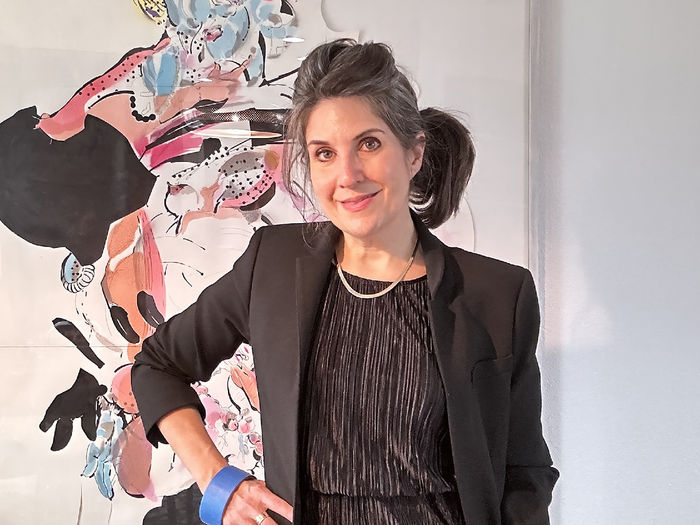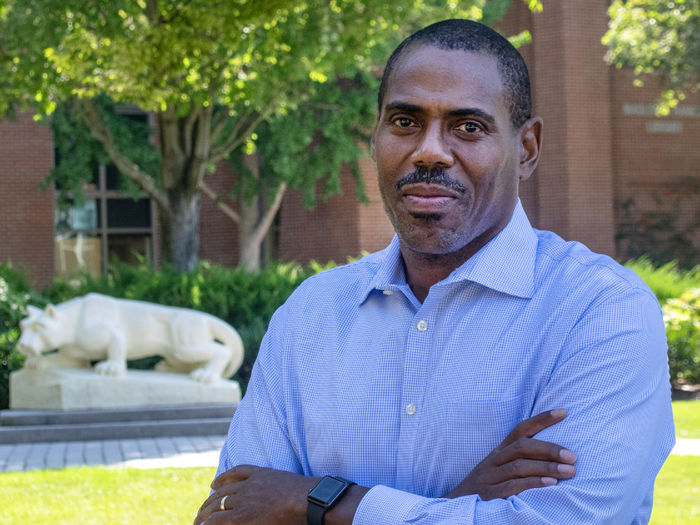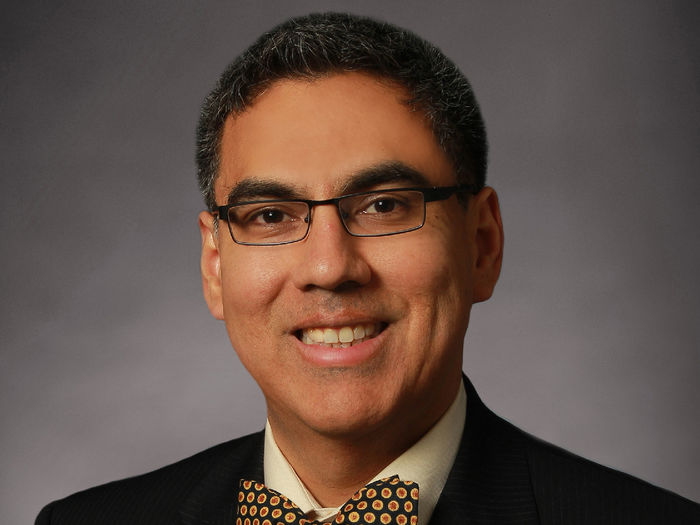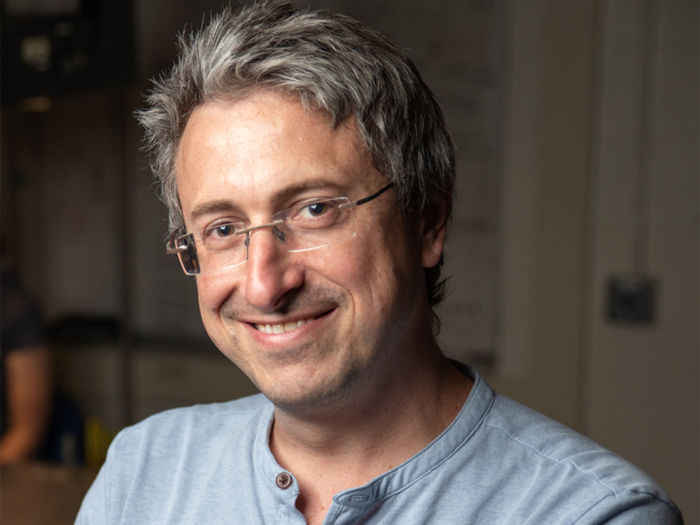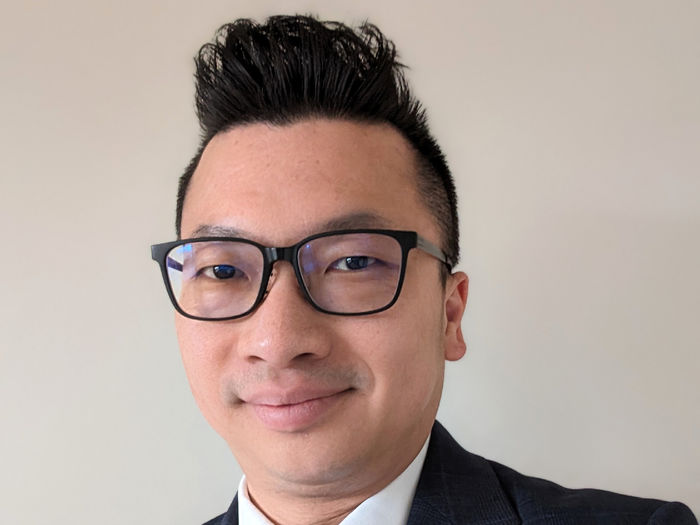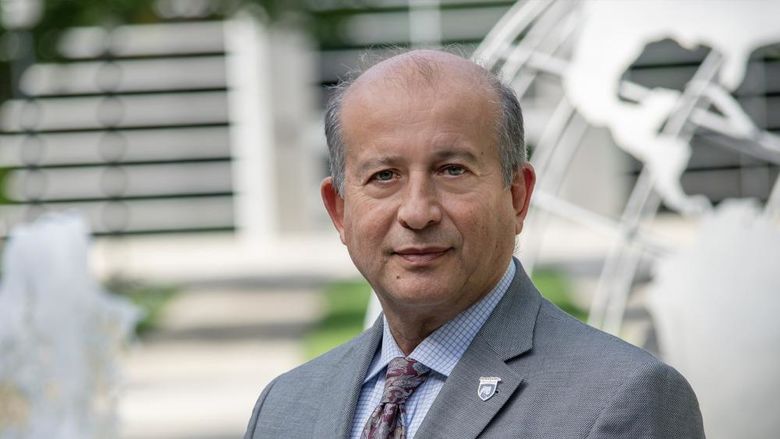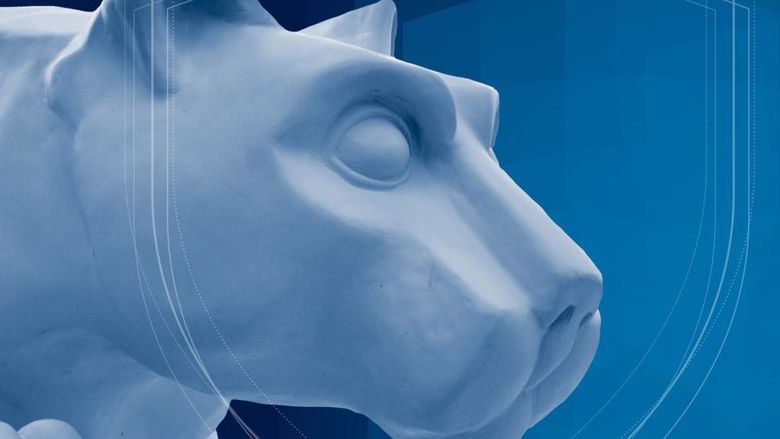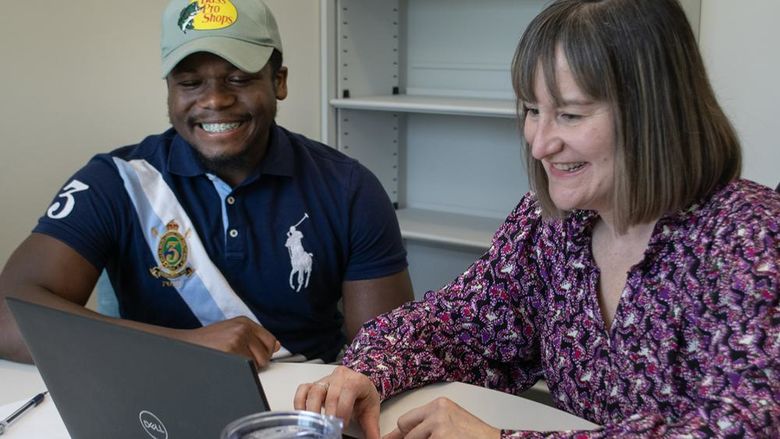UNIVERSITY PARK, Pa. — Six Penn State faculty members have received 2024 Faculty Scholar Medals for Outstanding Achievement.
They are Bonnie Collura, professor of art (sculpture) in the College of Arts and Architecture; Shaun Gabbidon, distinguished professor of criminal justice at Penn State Harrisburg; Enrique Gomez, professor of chemical engineering in the College of Engineering and by courtesy materials science and engineering in the College of Earth and Mineral Sciences; Katsuhiko Murakami, professor of biochemistry and molecular biology in the Eberly College of Science; Mikael Rechtsman, professor of physics in the Eberly College of Science; and Tak-Sing Wong, professor of mechanical engineering and biomedical engineering in the College of Engineering.
Established in 1980, the award recognizes scholarly or creative excellence represented by a single contribution or a series of contributions around a coherent theme. A committee of peers reviews nominations and selects candidates.
Bonnie Collura
Nominators said Collura uses her art to drive empathetic connections among people. She uses traditional and digital approaches to create art that allows people with different backgrounds to intersect. She earned the Faculty Scholar Medal for Arts and Humanities.
Nominators cited Collura’s project “Together, Tacit” as a groundbreaking accomplishment. In it, Collura uses her art to investigate questions related to artmaking practices, how artmaking privileges some individuals, and how institutions of higher learning promote inequities in access to the artistic process. Collura said the goal was to create an environment where the “visually impaired and sighted could work together to build sculptures inspired by how both groups ‘see.’ ”
“Professor Collura’s ‘Together, Tacit’ project is especially noteworthy,” a nominator said. “Through this collaborative project — which includes students and faculty members from engineering, computer science and technology — Professor Collura is exploring ways to bridge the world of individuals with low vision and blindness with that of sighted individuals to create a shared language for artmaking.”
In September 2023, the project partnered with Cincinnati’s Clovernook Center for the Blind and Visually Impaired for a workshop titled “Haptic Narratives”, which was organized by Collura. Nominators said it forced discussions about how visual thinking and haptic learning occurs.
“This focus of the ‘Together, Tacit’ project is both profound and exciting, but also emblematic of the long arc of Professor Collura’s practice,” a nominator said. “Her work has long been a celebration of process, craft and material engagement over easy outcomes and heroic product. This ethic in Collura’s work is both aesthetically captivating, but also deeply invested in the ethical, and inclusive. Simply put, Collura’s is among the most important sculpture practices today.”
Collura is an award-winning sculptor and educator, earning notable awards such as the Guggenheim Memorial Foundation Fellowship (2005), the MacDowell Colony Fellowship (2010), and the International Sculpture Center Outstanding Educator Award (2021). Her mixed-media sculptures have been included in national and international exhibitions such as Germany’s Koln Sculpture Park, France’s Collection Lambert en Avignon, and the Dallas Museum of Contemporary Art.
Nominators said Collura is equally respected as an educator. She’s developed courses, projects and events aimed at improving the student experience. Among her most noteworthy contributions, nominators said, is her Breakaway course, which is a course that helps undergraduate students explore and refine their professional skills in preparation for careers in the visual arts.
Shaun Gabbidon
Nominators said Gabbidon is internationally known for his research and publications in the specialty area of race and justice, making unique contributions in several areas. He earned the Faculty Scholar Medal for Social and Behavioral Sciences.
He’s co-developer of the Theory of African American Offending (TAAO), which nominators said produced a paradigm shift in criminological theories that have been used to explain racial disparities. The field has for more than a century relied on general theories to describe all types of offending. However, Gabbidon’s research, detailed in the co-authored work “A Theory of African American Offending: Race, Racism, and Crime,” considers historical factors of the African American experience in the United States. The work has been widely cited and has pushed scholars to further incorporate race-specific theories in criminology.
Nominators said Gabbidon continued to reshape research with his most recent work, “Shopping While Black: Consumer Racial Profiling in America,” which details racial profiling in retail settings. Gabbidon and a collaborator worked with a Fortune 500 company to analyze the policies and procedures for sales and loss prevention. In addition, they provided the company with a comprehensive analysis of shoplifting arrests in 42 of their stores and utilized an experimental audit study to chronicle the treatment of Black shoppers in retail stores in Manhattan. Nominators said it’s one of the most comprehensive studies on the subject.
Through books and research publications, Gabbidon continues to reshape how criminology and criminal justice are taught and researched by incorporating the contributions of Black scholars. Most notably, he co-authored the book “African American Criminological Thought,” which went back into the late 1800s and included voices of underrepresented scholars in the field.
Gabbidon is most widely known for his book “W.E.B. Du Bois on Crime and Justice: Laying the Foundations of American Criminology,” which eminent scholar Joseph Feagin wrote, “Shaun Gabbidon’s book on W.E.B. Du Bois and crime provides an original and innovative window into this little-known area of Du Bois’ research and thought.”
“Dr. Gabbidon’s intellectual contributions have been important and influential, and they have required the field of criminology to pay greater attention to racial inequality,” a nominator said. “His expansive contributions around this coherent theme have included consistent commitments to the critical task of diversifying criminology, through his stellar publication record but also through his mentoring, service and related community engaged work. This sustained record of contributions and their impact reflect his distinction in the field of criminology and criminal justice.”
Enrique Gomez
Nominators said Gomez is an expert on advanced soft material characterization techniques and was selected for his groundbreaking work in the understanding of water treatment membranes that use these materials. He earned the Faculty Scholar Medal for Engineering.
Nominators called his work “world-leading” while referring to his applications of electron microscopy, spectroscopy and X-ray scattering as “difficult and novel, departing from past methods and utilizing a wide range of techniques.”
Gomez’s work is critical to solving one of the United Nations Sustainable Development Goals: water and sanitation. According to the U.N., 2.2 billion people lack safely managed drinking water, and 3.5 billion people lack safely managed sanitation. Research such as Gomez’s membrane separations is a low-energy approach to solving that, nominators said. His research, which was featured on the cover of the research journal Science in 2021, demonstrates how polymer thin films can be used in water purification. Additionally, he’s revealed ways of improving membrane performance for biopharmaceutical processing, such as virus removal filters.
“Dr. Gomez’s scholarship and innovation over the past five years has led to his transformative application of advanced material characterization techniques to polymeric membranes,” a nominator said. “This work has already had significant international influence; it has the potential to impact billions globally.”
Gomez received numerous awards for his research, including the U.S. National Science Foundation’s (NSF) Creativity Award in 2023, and the American Chemical Society’s Cooperative Award in 2022. He was named a fellow of the American Physical Society in 2021 and a fellow of the Polymeric Materials: Science and Engineering Division of the American Chemical Society in 2024. He’s been invited to speak more than 30 times in the past five years.
The NSF, the Office of Naval Research (ONR) and the Department of Energy currently fund his research. He leads the Center for Self-Assembled Organic Electronics for ONR, which is a $7.5 million collaborative research project.
Nominators also cited Gomez’s commitment to improving diversity, equity, inclusion and belonging at Penn State. He serves as the College of Engineering’s interim associate dean for equity and inclusion and was recently associate head for diversity, equity and inclusion for the Department of Materials Science and Engineering. In 2023, he was awarded Penn State’s Charles Hosler Diversity, Equity and Inclusion Faculty Award.
“Water purification is one of the defining challenges of our generation, and Dr. Gomez has made key, transformative advances in this area,” a nominator said. “His remarkable creative contributions have leveraged the world-class research environment and resources at Penn State, including cutting-edge electron microscopy facilities. His creative achievements are an example of how Penn State can make an impact in addressing some of the most pressing problems that our society faces today.”
Katsuhiko Murakami
Nominators said Murakami is a renowned international scholar who has made exceptional breakthroughs in his field. He earned the Faculty Scholar Medal for Life and Health Sciences.
Murakami researches the structural and functional analysis of diverse RNA polymerases (RNAP), an essential enzyme in all living organisms responsible for synthesizing RNA during the process of transcription and is a critical component of the central dogma of molecular biology.
Nominators said Murakami uses X-ray crystallography to investigate the structural and mechanistic basis for the RNAP transcription and its regulation.
“Through his exemplary research program, he has become a highly visible and established leader in his field,” a nominator said. “His work is not only contributing to our fundamental knowledge of basic transcriptional processes required to express the genetic information from DNA in all living organisms, but it also has significant implications for therapeutics. He’s made several seminal discoveries to advance our fundamental understanding of bacterial and archaeal RNAPs and to shed light on clinically important mechanisms, including antibiotic resistance in tuberculosis.”
The research is contributing to overcoming the challenges of antibiotic resistance for bacterial infectious diseases. Murakami’s recent research publications point to how mutations in the RNAP of Mycobacterium tuberculosis — the bacteria responsible for tuberculosis — creates resistance to Rifampin/Rifampicin, the chief antibiotic used to fight against tuberculosis. This gives infectious disease experts a point of attack for identifying novel compounds that can effectively treat antibiotic resistant M. tuberculosis infections.
Murakami received awards for his research, including the Pew Biomedical Scholar in 2005, and he was named an American Association for the Advancement of Science fellow in 2020. The National Institutes of Health and the Pew Charitable Trusts currently fund his research. He leads the Cryo-EM facility and Center for Structural Biology of the Penn State Huck Institutes of the Life Sciences.
Nominators said Murakami’s discoveries came from pivoting away from classic X-ray crystallographic methods to harness the power of cryogenic electron microscopy (cryo-EM). They said it “accelerated and expanded the realm of possibilities for novel insights into mechanisms governing transcriptional regulation across living systems.”
“Murakami’s recent adoption of state-of-the-art advances in cryo-EM have allowed him to make exciting new discoveries that were previously impossible,” a nominator said. “The fruits of these efforts are now accelerating research aimed at understanding the fundamental intricacies of how an essential molecular machine functions in all organisms on earth and controlling bacterial pathogens by developing RNAP inhibitors based on new, detailed insights.”
Mikael Rechtsman
Since joining Penn State in 2015, nominators said Rechtsman has made the transition from rising star to international leader in photonics. He earned the Faculty Scholar Medal for Physical Sciences.
Since originating a new subfield of physics as a postdoctoral scholar with Moti Segev at the Technion (Israel Institute of Technology) — namely topological photonics — he has built tremendously on his pioneering work and has pushed into a variety of novel directions, both in topological physics and photonics more broadly, nominators said.
His initial research on this topic, published in Nature in 2013, provided the first experimental demonstration of a topological insulator for light, and the first observation of a “Floquet topological insulator.” These materials represent a new phase of matter with striking properties — they only allow wave propagation on their surfaces, and their properties are left unchanged even in the presence of disorder. They are predicted to have possible applications in photonics, including relating to more efficient lasers and quantum light sources. Nominators called it one of the most active current research areas in photonics and optical physics.
“Rechtsman has pushed into new domains of topological physics, which go significantly beyond what can be realized in condensed matter physics, consistently maintaining his group’s outstanding leadership in topological photonics,” a nominator said. “He has pioneered the exploration of nonlinear topological phenomena, a new area that represents completely different physics than the solid-state world.”
In 2018, in research again published in Nature, Rechtsman offered the first experimental demonstration of four-dimensional quantum Hall physics. Nominators said it was widely believed that quantum Hall physics occurs in four dimensions, yet, until Rechtsman, it had remained unknown since our space is restricted to three dimensions.
“Remarkably, Professor Rechtsman was able to show that in a 2D system, modulation in a two-dimensional parameter space can be used to achieve a topological pump that probes the 4D quantum Hall physics,” a nominator said. “This work significantly opens the way to experimentally explore higher dimensional topological physics.”
Nominators said Rechtsman also made pioneering contributions to the emerging area of nonlinear topological photonics. In papers published in Science in 2020 and Physical Review X in 2021, he reported the experimental observation and explored the properties of solitons — waves that act to guide themselves under conditions of very intense light — in his topological insulator system.
“Prior to his work, most topological photonics work focused on linear systems. Professor Rechtsman’s work again opened a new direction in the field of topological physics,” a nominator said.
He also introduced the concept of broadband topological slow light. This approach overcomes a fundamental trade-off in optical systems, namely between wide bandwidth and slow group velocity. It allows light to propagate unscathed by fabrication defects over long distances and simultaneously with many different wavelengths. As it does this, the light can interact strongly with the matter present, which can make a range of optical processes much more efficient.
“Rechtsman is clearly one of the leaders in the field of photonics,” a nominator said. “Remarkably, he has an entirely new and exciting area of science that is now associated with his name — topological photonics. He demonstrated outstanding scientific achievements and worldwide visibility.”
Tak-Sing Wong
Nominators said Wong is being honored for his pioneering research and inventions in the field of slippery liquid-infused surfaces. He earned the Faculty Scholar Medal for entrepreneurship, technology transfer and economic development.
“Tak-Sing’s exceptional creativity and intellectual prowess have led to the development of entirely unprecedented bio-inspired materials, representing a significant leap forward in scientific innovation,” a nominator said. “He has undeniably reshaped the trajectory of interfacial science and engineering with his revolutionary and genuinely innovative contributions to the theoretical and experimental advancement of bio-inspired materials. Through his pioneering work, Wong harnessed these materials in creative and impactful engineering applications, some of which were previously beyond imagination.”
Wong is internationally recognized for his slippery surfaces inventions, which was inspired by the Nepenthes pitcher plant, including slippery liquid-infused porous surfaces (SLIPS), slippery-rough surfaces (SRS), and liquid-entrenched smooth surfaces (LESS). These technologies led to the creation of liquid-repellent coating design and development, leading to hundreds of related patents from Fortune Global 500 companies, including several of his own. As director of the Laboratory for Nature-Inspired Engineering, Wong also led the development of self-healing surgical films and synthetic brochosomes.
“Dr. Wong has devoted significant effort to remarkable success in translating his fundamental research from the lab to commercialization, thereby expanding the impact of his work,” a nominator said. “His achievements as an inventor are demonstrated by 65 issued and pending patents.”
In the past five years, Wong was granted 19 U.S. patents and 17 international patents. His patents related to liquid-infused coatings have been licensed to three multimillion-dollar companies, for products used in the medical, sanitation, marine, automotive and consumer packaged goods industries.
In 2018, Wong co-founded spotLESS Materials Inc., which creates products that aim to tackle global issues of sanitation and water scarcity. Procter & Gamble called the company’s sprayable, nonfouling, liquid-infused surface coating one of the top innovations in the P&G Innovation Challenge in 2021. It also won the TechConnect Innovation Award in 2021. These products are now being used in all 50 states and in 28 countries.
Wong’s research has been supported by the NSF, ONR, Defense Advanced Research Projects Agency, the National Institutes of Health, and the Advanced Projects Research Agency – Energy.
“Wong’s groundbreaking contributions in pioneering a new class of biomimetic liquid-repellent coatings have profoundly influenced both academic research, industrial applications, and beyond in the last decade,” a nominator said. “He epitomizes Penn State’s commitment to scientific discovery, technology innovation and global impact.”
